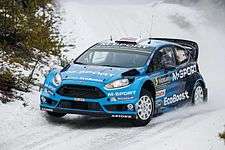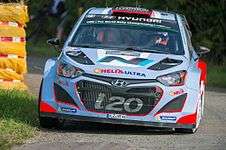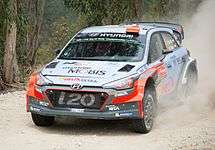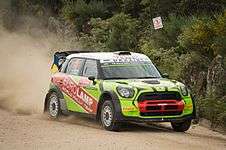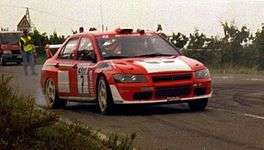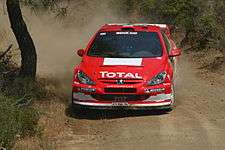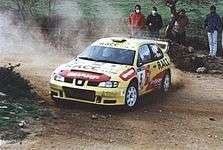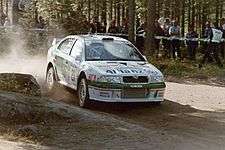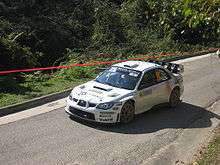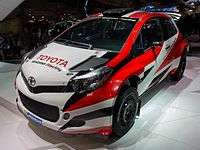World Rally Car
| World Rally Championship |
|---|
| Related articles |
|
Classes of competition Support championships |
| Lists |
World Rally Car is a racing automobile built to the specification set by the FIA, the international motorsports governing body and compete in the outright class of the World Rally Championship (WRC). The WRC specifications were introduced by the FIA in 1997.[1]
Regulations
1997–2010

Between 1997 and 2010, the regulations mandated that World Rally Cars must have been built upon a production car with a minimum production run of 2500 units. A number of modifications could be made including increasing the engine displacement up to 2.0L, forced induction (including an anti-lag system), addition of four wheel drive, fitment of a sequential gearbox, aerodynamic body modifications, weight reduction to a minimum of 1230 kg and chassis strengthening for greater rigidity.
Unlike the requirements for the preceding Group A cars, manufacturers were no longer required to build "homologation specials" in order to meet approval. The base model did not need to have all the characteristics of the WRC car, as evidenced from cars such the Peugeot 206, 307, Citroën Xsara and Škoda Fabia, which during this period had no road car variant with a turbocharged petrol engine or four wheel drive.
To limit power, all forced induction cars were fitted with a 34 mm diameter air restrictor before the turbocharger inlet, limiting the air flow to about 10 cubic meters per minute. The restriction was intended to limit power output to 300 hp although some WRC engines were believed to produce around 330–340 hp. Engine development did not focus on peak power output but towards producing a very wide powerband (or power curve). Typically, power output in excess of 300 hp was available from 3000 rpm to the 7500 rpm maximum, with a peak of 330–340 hp at around 5500 rpm. At 2000 rpm (the engine idle speed in "stage" mode) power output was slightly above 200 hp.[2]
2011–2016
Starting in 2011, rules for WRC cars have changed to be more restrictive. Now the regulations are derived from the ones for S2000 cars, with a different engine and an aerodynamic kit. The cars are smaller models (there is no longer a minimum 4m length), with a 1600 cm3 direct injection turbo engine with a 33 mm diameter air restrictor and a maximum pressure of 2.5 bar absolute (this will limit torque to about 400 N.m or less[3]).
Exotic materials (titanium, magnesium, ceramics and composite) are forbidden except when present in the base model. Carbon fibre and aramid fibre are very restricted ("only one layer of fabric is used and is affixed to the visible face of the part"), except for bodywork's side protections where multiple layers of aramid fibre are allowed.
The gear changes must be made with a mechanical system, so the paddle shifters are not allowed. However the system was re-allowed in 2015. There is no center differential (earlier it used to be 3 differentials, with a center/3rd differential included), but the new regulation allows only front and rear axle differential (eliminating the center differential to reduce cost), and they must be mechanical, without electronic control or hydraulic or viscous systems (from 2006 to 2010 the center differential and previously all 3 could be active[4]). Minimum weight is 1200 kg empty and 1350 kg with driver and co-driver (in both cases with only one spare wheel).[5]
2017
1600 cm3 turbocharged engine will be retained in upcoming 2017 World Rally Car regulations, but the turbo restrictor diameter will be increased from 33 mm to 36 mm, and remain at 2.5 bar of maximum pressure. It means an increase in the engine's power output from 300 bhp (223.7 kW) to 380 bhp (283.4 kW), the equivalent of a TC1-specification World Touring Car Championship engine. Minimum weight will be decreased by 25 kg.
Manufacturers are also given more freedom to maximise aerodynamic performance, and also allow to use active differentials on the centre, while the front and rear differentials remain mechanical.
While 2011 specification World Rally Cars will be allowed to compete in 2017, the new World Rally Cars are allowed for use by manufacturers' teams only .
Cars
|
References
- ↑ "WRC History". Suzuki Sport.
- ↑ "Subaru Rally Engine – Developing a World Rally Car power plant", page 23-30, Race Engine Technology, issue 005, 2004
- ↑ For instance, officially the Citroën DS3 WRC has 350 N·m (35.7 kgf·m) at 3,250rpm.
- ↑ "Rally of Turkey 2010 – Glossary". Retrieved 2011-02-21.
- ↑ http://argent.fia.com/web/fia-public.nsf/92B8777DD7239078C1257802003B3157/$FILE/255A_2011.pdf
External links
| Wikimedia Commons has media related to World Rally Championship cars. |

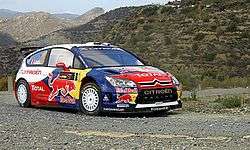
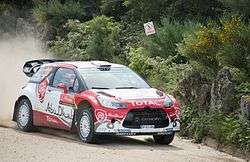
.jpg)

